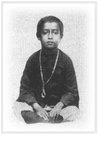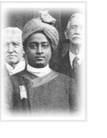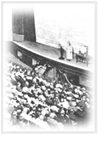|
||||
|
||||
Upcoming Events
Six-Hour Meditation
A six-hour meditation will be led by lay disciples accompanied by the Temple’s Kirtan group on Saturday, July 27th from 9:00 am to 3:00 pm. There will be an intermission halfway through this long meditation.
A six-hour meditation will be led by lay disciples accompanied by the Temple’s Kirtan group on Saturday, July 27th from 9:00 am to 3:00 pm. There will be an intermission halfway through this long meditation.
India Night
Please join us for Fullerton Temple annual India Night on Saturday, August 10th from 5:30 pm to 8:30 pm, an evening of spiritual fellowship, delicious home cooked Indian dinner, and a classical Indian dance performance. Please purchase your tickets in advance in the courtyard after the Sunday Services at $15 for adults and $5 for children. Space is limited so get your tickets early! The funds raised will go towards general temple operations and building improvements. Sign up here or at the table in the courtyard after the Sunday Service.
Please join us for Fullerton Temple annual India Night on Saturday, August 10th from 5:30 pm to 8:30 pm, an evening of spiritual fellowship, delicious home cooked Indian dinner, and a classical Indian dance performance. Please purchase your tickets in advance in the courtyard after the Sunday Services at $15 for adults and $5 for children. Space is limited so get your tickets early! The funds raised will go towards general temple operations and building improvements. Sign up here or at the table in the courtyard after the Sunday Service.
Service and Meditation Hours
Sunday
10:00 am - Meditation
11:00 am - Lecture Service
10:00 am - Meditation
11:00 am - Lecture Service
Saturday
6:00 pm - Energization Exercises
6:20 pm - Meditation
6:00 pm - Energization Exercises
6:20 pm - Meditation
First Thursday of the Month
7:30 - 8:30 pm Kirtan/Beginner’s Guided Meditation
7:30 - 8:30 pm Kirtan/Beginner’s Guided Meditation
Online Offerings
2024 SRF World Convocation continues to inspire. Click here for more details.
Prayer Request
You are welcome to submit a prayer request for yourself, your family, or friends. Monastics as well as lay members pray for those in need and for our world family as a whole.





 Paramahansa Yogananda was born Mukunda Lal Ghosh on January 5, 1893, in Gorakhpur, India, into a devout and well-to-do Bengali family. From his earliest years, it was evident to those around him that the depth of his awareness and experience of the spiritual was far beyond the ordinary. In his youth he sought out many of India’s sages and saints, hoping to find an illumined teacher to guide him in his spiritual quest.It was in 1910, at the age of 17, that he met and became a disciple of the revered Swami Sri Yukteswar Giri. In the hermitage of this great master of Yoga he spent the better part of the next ten years, receiving Sri Yukteswar’s strict but loving spiritual discipline. After he graduated from Calcutta University in 1915, he took formal vows as a monk of India’s venerable monastic Swami Order, at which time he received the name Yogananda (signifying bliss, ananda, through divine union, yoga). His ardent desire to consecrate his life to the love and service of God thus found fulfillment.
Paramahansa Yogananda was born Mukunda Lal Ghosh on January 5, 1893, in Gorakhpur, India, into a devout and well-to-do Bengali family. From his earliest years, it was evident to those around him that the depth of his awareness and experience of the spiritual was far beyond the ordinary. In his youth he sought out many of India’s sages and saints, hoping to find an illumined teacher to guide him in his spiritual quest.It was in 1910, at the age of 17, that he met and became a disciple of the revered Swami Sri Yukteswar Giri. In the hermitage of this great master of Yoga he spent the better part of the next ten years, receiving Sri Yukteswar’s strict but loving spiritual discipline. After he graduated from Calcutta University in 1915, he took formal vows as a monk of India’s venerable monastic Swami Order, at which time he received the name Yogananda (signifying bliss, ananda, through divine union, yoga). His ardent desire to consecrate his life to the love and service of God thus found fulfillment. In 1920, Yogananda was invited to serve as India’s delegate to an international congress of religious leaders convening in Boston.His address to the congress, on “The Science of Religion,” was enthusiastically received. That same year he founded Self-Realization Fellowship to disseminate worldwide his teachings on India’s ancient science and philosophy of Yoga and its time-honored tradition of meditation.
In 1920, Yogananda was invited to serve as India’s delegate to an international congress of religious leaders convening in Boston.His address to the congress, on “The Science of Religion,” was enthusiastically received. That same year he founded Self-Realization Fellowship to disseminate worldwide his teachings on India’s ancient science and philosophy of Yoga and its time-honored tradition of meditation.
 Over the next decade, Yogananda traveled and lectured widely, speaking to capacity audiences in many of the largest auditoriums in the country — from New York’s Carnegie Hall to the Los Angeles Philharmonic. The Los Angeles Times reported: “The Philharmonic Auditorium presents the extraordinary spectacle of thousands….being turned away an hour before the advertised opening of a lecture with the 3000-seat hall filled to its utmost capacity.”
Over the next decade, Yogananda traveled and lectured widely, speaking to capacity audiences in many of the largest auditoriums in the country — from New York’s Carnegie Hall to the Los Angeles Philharmonic. The Los Angeles Times reported: “The Philharmonic Auditorium presents the extraordinary spectacle of thousands….being turned away an hour before the advertised opening of a lecture with the 3000-seat hall filled to its utmost capacity.” In 1935, Yogananda began an 18-month tour of Europe and India. During his yearlong sojourn in his native land, he spoke in cities throughout the subcontinent and enjoyed meetings with Mahatma Gandhi (who requested initiation in Kriya Yoga), Nobel-prize-winning physicist Sir C. V. Raman, and some of India’s renowned spiritual figures, including Sri Ramana Maharshi and Anandamoyi Ma. It was during this year also that his guru, Swami Sri Yukteswar, bestowed on him India’s highest spiritual title, paramahansa. Literally supreme swan (a symbol of spiritual discrimination), the title signifies one who manifests the supreme state of unbroken communion with God.
In 1935, Yogananda began an 18-month tour of Europe and India. During his yearlong sojourn in his native land, he spoke in cities throughout the subcontinent and enjoyed meetings with Mahatma Gandhi (who requested initiation in Kriya Yoga), Nobel-prize-winning physicist Sir C. V. Raman, and some of India’s renowned spiritual figures, including Sri Ramana Maharshi and Anandamoyi Ma. It was during this year also that his guru, Swami Sri Yukteswar, bestowed on him India’s highest spiritual title, paramahansa. Literally supreme swan (a symbol of spiritual discrimination), the title signifies one who manifests the supreme state of unbroken communion with God. Yogananda’s life story,
Yogananda’s life story,  On March 7, 1952, Paramahansa Yogananda entered mahasamadhi, a God-illumined master’s conscious exit from the body at the time of physical death. His passing was marked by an extraordinary phenomenon. A notarized statement signed by the Director of Forest Lawn Memorial-Park testified: “No physical disintegration was visible in his body even twenty days after death….This state of perfect preservation of a body is, so far as we know from mortuary annals, an unparalleled one….Yogananda’s body was apparently in a phenomenal state of immutability.”
On March 7, 1952, Paramahansa Yogananda entered mahasamadhi, a God-illumined master’s conscious exit from the body at the time of physical death. His passing was marked by an extraordinary phenomenon. A notarized statement signed by the Director of Forest Lawn Memorial-Park testified: “No physical disintegration was visible in his body even twenty days after death….This state of perfect preservation of a body is, so far as we know from mortuary annals, an unparalleled one….Yogananda’s body was apparently in a phenomenal state of immutability.”